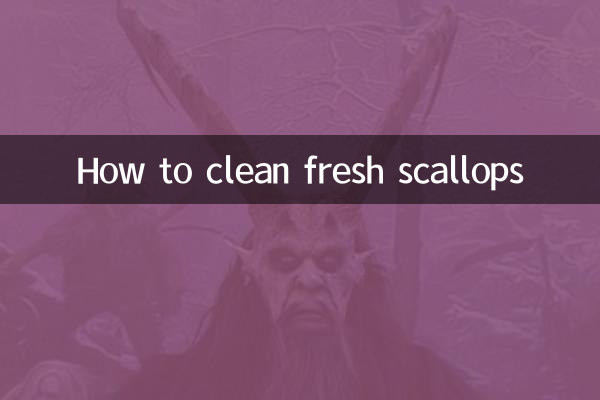How to clean fresh scallops: seafood processing techniques that are hotly discussed on the Internet
Recently, seafood handling techniques have become a hot topic, especially the cleaning method of fresh scallops. Many netizens shared their experiences on social platforms, triggering widespread discussions. This article will combine the hot content on the Internet in the past 10 days to provide you with a detailed analysis of the correct cleaning steps for fresh scallops, and provide structured data to help you easily master this skill.
1. The importance of cleaning fresh scallops

Fresh scallops are a high-protein, low-fat seafood, but if not cleaned properly, sediment or odor may remain, affecting the taste. Here are the key reasons for cleaning fresh scallops:
| Reason | Description |
|---|---|
| Remove sediment | Fresh scallops may be adhered to seabed sediment and need to be cleaned thoroughly. |
| Reduce fishy smell | Cleaning can remove some of the fishy smell and enhance the flavor of cooking. |
| Ensure hygiene | Avoid bacterial or parasite residues to ensure safe consumption. |
2. Detailed explanation of the steps for cleaning fresh scallops
According to the hot discussion on the Internet, the following is the standard process for cleaning fresh scallops:
| steps | Operating Instructions |
|---|---|
| 1. Preliminary rinse | Rinse the surface with running water to remove obvious impurities. |
| 2. Soak in salt water | Soak the fresh scallops in light salt water for 10 minutes to soften the dirt. |
| 3. Brush the shell | Use a soft-bristled toothbrush to gently brush the edges and folds of the scallops. |
| 4. Remove the internal organs | Use a knife to cut open the scallops and remove the black or brown internal organs. |
| 5. Rinse again | Rinse thoroughly with clean water until the water is clear and free of impurities. |
3. Notes hotly discussed by netizens
Recently on social platforms, many users have shared additional tips for cleaning fresh scallops:
1.water temperature control: Avoid using hot water, otherwise the meat of the scallops will become hard.
2.Tool selection: It is recommended to use a food-grade soft-bristled brush to avoid scratching the surface of the scallop.
3.Timing: The soaking time should not exceed 15 minutes, otherwise the umami flavor will be lost.
4. Preservation method of fresh scallops after cleaning
If the fresh scallops are not consumed immediately after cleaning, they must be properly stored. The following are the recommended storage solutions across the web:
| Save method | duration | Remarks |
|---|---|---|
| Refrigerated | 1-2 days | It needs to be wrapped in plastic wrap to prevent moisture loss. |
| frozen | 1 month | It is recommended to pack separately to avoid repeated thawing. |
5. Common misunderstandings about cleaning fresh scallops
In conjunction with hot-spot discussions, the following misunderstandings require special attention:
1.excessive cleaning: Washing with force will destroy the fiber structure of the scallops and affect the taste.
2.Ignore the entrails: Failure to remove the guts completely may result in a bitter taste or hygiene issues.
3.Use chemical cleaners: Detergent and other products may contain harmful substances, just use clean water.
Conclusion
Cleaning fresh scallops may seem simple, but details determine success or failure. Through the structured data and step-by-step analysis of this article, you can not only avoid common misunderstandings, but also retain the delicious original flavor of scallops. It has also been emphasized in recent hot topics that the correct cleaning method is the first step in seafood cooking and deserves the attention of every food lover.

check the details

check the details